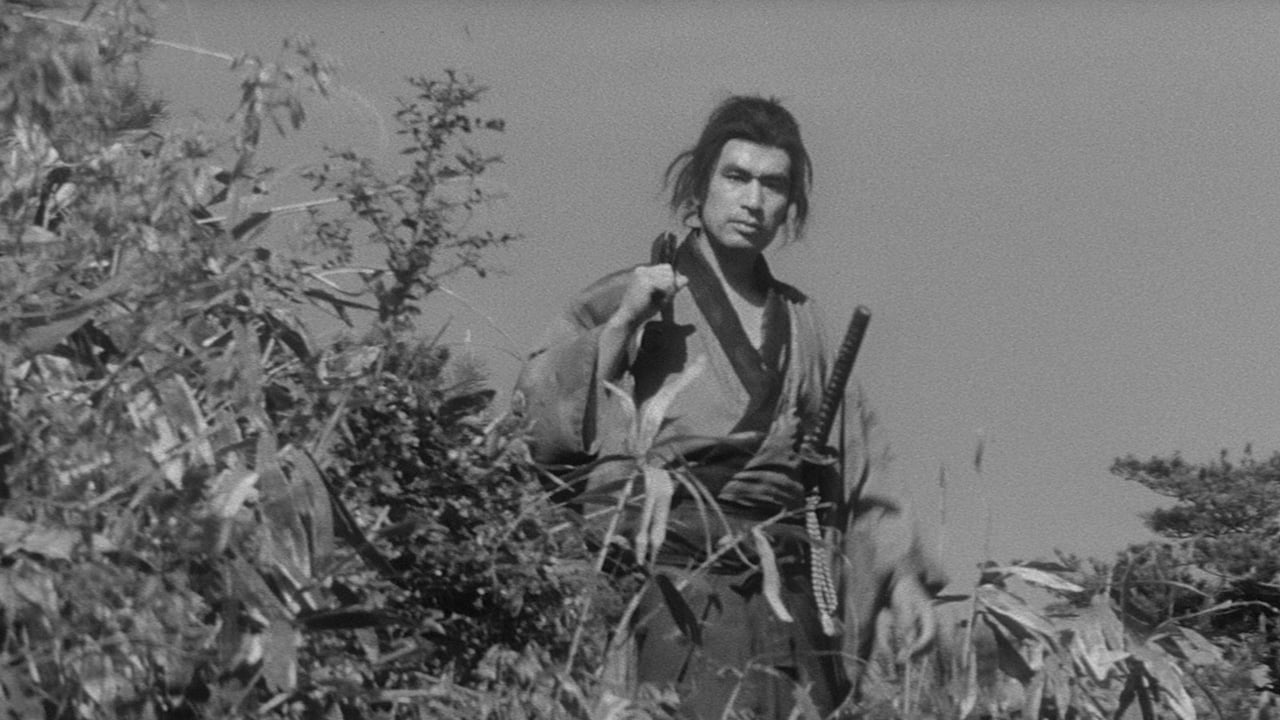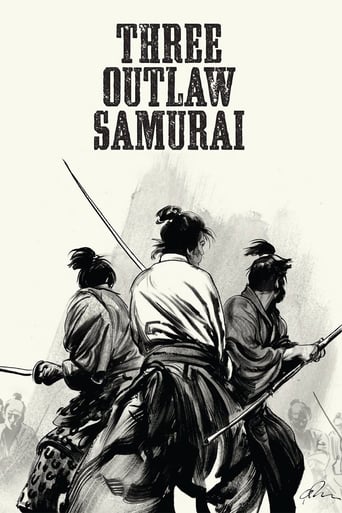

Three Outlaw Samurai is an incredibly accomplished debut feature from acclaimed director, Hideo Gosha. Dealing with familiar samurai themes of honour and loyalty the film distinguishes itself from the competition due to its unwavering cynicism.The film follow three different samurai warriors. Each who are different type of the loyal swordsman. But you could ask. Loyalty to whom? Loyalty to a system you in your heart believe is wrong? Is it your duty to fight for a cause that not many people are willing to risk their lives for? And who's lives are worth sacrificing for the sake of the greater cause? There's also a great deal of mistrust for authorities in the film. I suspect that is one of Hideo Gosha's trade marks, together with not being that interested in portraying the samurai as just a honorable code follower. This being more a film about class and empathy than anything else, and it's all quite interesting if you consider the small scale socialistic revolution that's going on here.The film is doesn't shy away from showing the violence. In modern action films they cut fast through the action. Here, you can follow the action without having too many unnecessary cuts. It feels like the characters is actually fighting, not that it is staged which makes it more realistic.The cinematography was excellent. I was also impressed by how well the film was shot. That the contrasts between black and white resemble the appearance of a clean chessboard. Everything is so marvelously framed, and the camera so exquisitely balanced. With intrepid camera stunts that range from panoramic landscapes to long horizontal tracking shots, that the action, tension, betrayal, terror and even the heartwarming moments are brought to their full audience-involvement capacity. It maximizes the potential for such a simple plot. Not a single second is wasted, as all events portrayed are of understandable importance to the evolution of the story, with a timing that never bores or irritates.It was also apparent that Three Outlaw Samurai has been a major influence on all of the samurai films that we see today. I also read that this is an inspiration for Star Wars Episode VIII: The Last Jedi. Hope the fight scenes in The Last Jedi are similar to the final fight scene in this movie.In the end this is a movie where not a single person is to be trusted. It is a bloody, deceitful, beautiful film. I highly recommended!
... View MoreThree Outlaw Samurai is massively successful at being a tough, no-punches-pulled story of a corrupt Magistrate (as well as samurai, whether former or not who can say, he barely acts like one) who reveals his true colors when a few peasants kidnap his daughter and hold her for ransom. At first, when we're introduced to these peasants (who barely have enough food for porridge) by way of the wandering, rogue samurai Sakon Shiba (sort of a 2nd tier Toshiro Mifune as by Tetsurô Tamba, but this is still to say he's superior likely to about a dozen other leading men from the time), it seems like the peasants may be the "bad" guys, though Shiba actually sides with them and doesn't mind - on the contrary encourages, almost out of a curious sense of 'lets see where this goes' lackadaisical attitude - for the peasants to continue. There are also two other samurai at different positions in this village, Sakura and Kikyo, who have varying personalities and attitudes to the magistrate (the latter is even more cynical than Shiba, Sakura a little more of a 'I might try to do good... maybe, at least I have more of a heart or conscience' type), and the first act deals with this hostage stand-off.I was entertained by this first part, and felt like I was settling in reasonably well into the world of this village where it seemed like a stand-off thriller involving samurai and peasants would take place.... and then the turning point happens where the Magistrate tries to give one of the peasants a taste of his own medicine (his daughter now under capture, plus a rape is more than implied), and this sort of trade-off of the two sides goes very poorly. But when Shiba tries to do the honorable thing - roving and Yojimbo-ish as he may be, he's still got a samurai's code of right and wrong - and take the brunt of the punishment, this also goes quite badly as the Magistrate turns out to be the villain of the story.While Three Outlaw Samurai may draw in viewers based on the promise of a lot of action and thrills and blood (albeit in black and white, which has its own electrical charge as far as seeing what effect happens, and always these fights are scored without music to heighten the tension and realism), it's actually a story of politics, both in how the Magistrate has no compunction about being corrupt but, hey, let's make sure everything's set and proper for the (superior to him) Lord's arrival in a few days, while not giving a damn about anyone or anything, least of all his samurai code. It's here that Gosha is able, on his first outing as director (man what a debut!), to get a lot of substance out of what is a slim volume of a movie at 93 minutes. This is a samurai movie made by people who love samurai movies for samurai movie fans, if that makes sense; it's hard and cold and grisly for a lot of the time, and yet the hopelessness, the feeling that any one of our main samurai could die if they're not on the total alert (the Magistrate has his hired killers like out of, to be sure, an old western with the desperadoes coming after the good gunslingers), adds another level to things.There may be a couple of nitpicks to have with a couple of the supporting players - the women in the film, more-so Oine than Aya but kind of both - are developed only up to a point, and Aya's character arc, while there, is kind of just in the backdrop (maybe a longer running time could've given her more to do, I don't know, she's an okay actress). Some of this may be a flaw with the writing too, or like that moment near the climax when (speaking of Star Wars again) the Han Solo-ish 'I'm leaving, no, wait, I'm going back to my friends' moment happens, which isn't unexpected, but Oine's reaction is really over the top. It wouldn't be so noticeable if everything else wasn't pitched at such a degree of realistic drama; it is theatrical, practically all of the performances, but I was struck by how Gosha made the suspense so moment-to-moment and beat-to-beat so that you never question the logic of how a characters gets out of something: it's all about who can possibly get the sword out faster and do the better/smarter move.I loved the action in this film, from how it's shot to how the actors play off of one another, and there is character to it - how Shiba fights is different than Sakura, so while they have strong technique they are distinct too in how the characters approach fighting off the other swinging-swordsmen - and I loved these actors in these main roles. At times the tone of Three Outlaw Samurai is bleak and unsettling, but that is what makes it... sorry for the lack of a better phrase, but it's bad-ass. It's simply that: it all builds up to a ferocious climax where it's unpredictable how it'll turn out - I wasn't sure who might get away from the couple of dozen swordsmen out on the three's asses - and yet the substance of the story drew me in too, how these peasants react (or don't) to Shiba and his (anti)heroic movements. There's revenge, there's loyalty, there's death-defying strokes of heroism (maybe against better judgment) and all shot in shockingly good black and white photography that always has a purpose in every movement and cut.PS: Some of the sword-fighting is, according to director Rian Johnson, a big inspiration for the upcoming Star Wars film The Last Jedi. Whether it's the Hidden Fortress or this, it's great to see Japanese cinema in the blood of sci-fi fantasy.
... View MoreViewed on DVD. Restoration = ten (10) stars. Director Hideo Gosha has conjured up yet another version of a samurai sub-cultural way of life in this 1964 photo play. The interactions between different food-chain classes of sword swingers and different/aberrant samurai honor codes within the same samurai class make for welcomed breaks between typical (more or less) slashing scenes. The plot revolves around three samurai who are torn between the plight of the down trodden (as usual) peasants (here the lowest of the low class from which these samurai seemed to have emerged (and would probably like to--but can not--forget) and the local rulers who pay slasher salaries. (What might make for a far more interesting script would be to explore how peasants managed to become skilled and educated samurai equal to those who have inherited samurai class standing). Acting is for the most part dynamic (and not role-based stereotypical--facial expressions are hard to forget), and directing/editing is first rate. Cinematography (wide-screen, black and white) and scene lighting are excellent. Music is a bit jarring, but otherwise OK. Subtitles seem reasonably close to the actual dialog which is a challenge to always comprehend due to the use of regional slang. Worth watching once. WILLIAM FLANIGAN, PhD.
... View MoreExcellent black and white cinematography, solid acting, well done action and a reasonably good story make this a satisfying film. The story of wandering samurai coming to the aid of impoverished farmers is not new and the characters are stock but this isn't a real problem if you are looking for something to sit back and enjoy easily. The direction is very assured and it's remarkable that this is a first directorial effort. The actors are appealing and the film never gets bogged down in long exposition or beauty shots. The comparison to a spaghetti western is apt.The film seems like it was intended to start a series based on the three characters. Too bad that didn't happen.
... View More